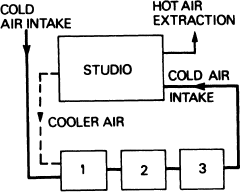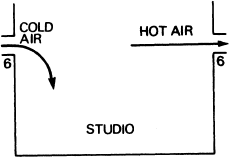Studio Ventilation
All ventilation and air-conditioning systems must be considered at the early design stages of the studio complex. Not only the studio itself, but the control rooms, make-up and costume areas, tape and film storage area and technical equipment racks, all have their particular air-control requirements. The studio production lighting generates about 1 kilowatt of heat for every kilowatt of power consumed. This causes a heat build-up which is not only tiring for performers and studio staff alike, but reduces their efficiency considerably.
Preventing heat build-up
Heat build-up in the studio can be reduced to some extent by using:
● Sensitive cameras, and hence lower wattage lamps for the lower light levels needed.
● A lighting console to switch off lamps when they are not in use. A good practice is to start rehearsals with the dimmers set at half their maximum light output (often 7 on the fader), and so produce less heat.
● A high studio ceiling so that the hot air is suspended well above the studio floor.
● A well-planned ventilation and air-conditioning system.
The function of the ventilation system is to remove the hot air and replace it with cool dry air. The exact requirements are determined by the size of the studio and its commitments, i.e. continuous or intermittent use, small sets or large sets, etc.
General problems
Problems associated with the general system are:
● The scenery will probably not be in identical positions for each production and may sometimes obstruct low-level fresh-air intakes.
● The ventilation system should be capable of changing the studio air several times an hour, i.e. large volumes of air have to be moved. To reduce the noise of the air flow the ventilation ducts should be of large cross sectional area so that the rate of flow of air can be slow (see page 22). One way of overcoming the noise problem cheaply is to use a very fast (but noisy) extraction system intermittently, e.g. during initial rehearsals, recording breaks, etc. Such a system should be fitted with suitable shutters to retain good sound insulation when it is not in use.
Auxiliary requirements
The studio’s associated technical and production areas also require air conditioning; otherwise they will become hot and stuffy.
Technical equipment, especially racks of thyristor dimmers, should have forced ventilation to ensure its stability and reliability.
The power requirements of the ventilation system should be taken into account at the initial planning stage.
Basic studio ventilation system
If the ventilation system is to be used continuously, it should be capable of handling two-thirds of the maximum lighting power in the form of heat. Use could be made of the extracted hot air for heating the studio complex. With filter (1), cooler (2) and heater (3).

Ventilation trunks
Method of introducing cold air over the top of the scenery by means of large diameter trunks (5).

Ventilation shelves
Simple method for introducing cold air and extraction of the hot air by means of two ventilation shelves (6) which extend along the length of the studio.

Intermittent usage
Ventilation system for intermittent use (not during transmission or recording). Heavy duty extraction fans (7). Shuttered air vents (8).

